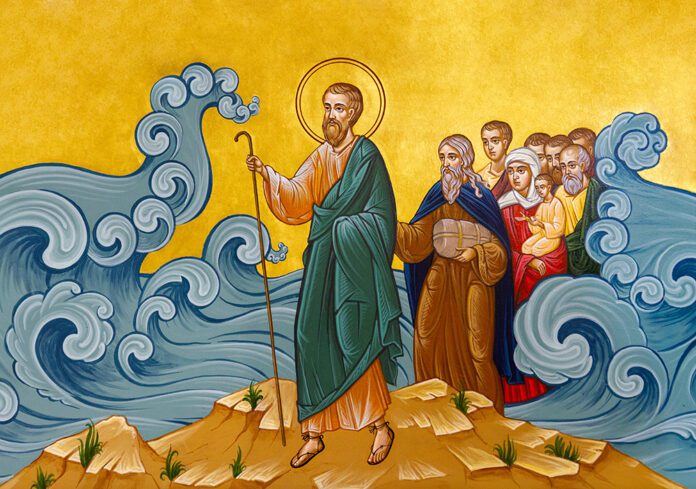After the Passover, Pharoah is distraught by the devastation of all ten plagues and finally agrees to let the Israelites go. The Israelites, who ate the Passover meal prepared for a journey, left and were given many treasures from the people of Egypt because they were fearful of the might of God (this gold would eventually be used to make the golden calf). However, as the people were leaving, Pharaoh changed his mind and decided to go after the people of Israel to once again enslave them.
God, aware that Pharaoh would change his mind, had led the people through the wilderness, away from the land of the Philistines who would have engaged the Israelites in battle. By day, God led them by a pillar of cloud and by night God led them by a pillar of fire. Pharaoh gathered his army and chariots and pursued Israel into the wilderness to trap them by the Red Sea. When they caught up to Israel, the people complained to Moses, wishing they had never left. But God assured Moses that today He would fight for the people. Moses was instructed to stretch out his staff and part the Red Sea for the people of Israel to walk on dry land with the water like a wall to the right and the left. At the same time, God who had been leading the Israelites, now placed Himself between the Israelites and Egyptian army. It had turned to night time so He was in the form of a pillar of fire.
All night the Israelites trekked through the Red Sea on dry land with God as their rear guard. The Egyptians still had the audacity to pursue the Israelites through the sea. However, God sent their army into confusion as the Israelites successfully crossed to the other side. Then both sides of the watery passage flowed back upon the Egyptian army and not one of them escaped. When the Israelites saw that God had indeed fought for His people, they praised Him with song and believed.
This is one of the most famous stories of the Old Testament. The typological significance cannot be understated. The passage through the Red Sea is a foreshadowing of the Christian baptism. As the Israelites are freed from the slavery of Egypt passing through water, so we are freed from our slavery to sin by being baptized. Just as the passage through the Red Sea begins the Israelites journey through the wilderness to the promised land, Baptism marks the beginning of an earthly journey with God to our Heavenly home.
We can also learn about the sinful nature of our hearts from observing Pharaoh. Once he realizes the loss of the comfort of the Israelite peoples’ slavery, he immediately chases after them. Even though he had just experienced the 10 plagues and lost his first born son because he defied God, Pharaoh refused to give up his sin to the point of losing his entire army. Conversion does not happen primarily by reacting to externals. The external signs are secondary and if they are the basis of our faith in God, we will eventually forget.
True conversion happens in the heart. Every step of the way Pharoah is reactionary to his immediate external comforts and how God’s might affects them. However, no form of repentance sticks because His heart is not changed. We see this happen many times with Jesus. Many people, especially the Pharisees, see the acts of Jesus. Yet, these signs are not proof enough for the heart. It is the conversion of the soul that leads people to have love and faith in God. By the end of the story, the Israelites are in the same situation. They see the mighty act of God who saves them and they praise Him and believe. However, as we will see, the conversion will not occur in their hearts. As they continue their journey their faith will be tested many times and God will have to prove His love for them many times due to the stubbornness of their hearts.


